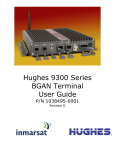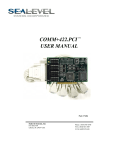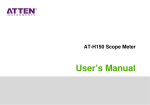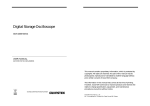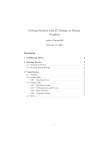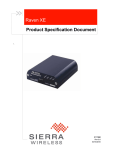Download GDS-2000 Series - TEquipment.NET
Transcript
Digital Storage Oscilloscope Logic Analyzer GDS-2000 Series & GLA-1000 Series Training MANUAL GW INSTEK PART NO. This manual contains proprietary information, which is protected by copyrights. All rights are reserved. No part of this manual may be photocopied, reproduced or translated to another language without prior written consent of Good Will company. The information in this manual was correct at the time of printing. However, Good Will continues to improve products and reserves the rights to change specification, equipment, and maintenance procedures at any time without notice. ISO-9001 CERTIFIED MANUFACTURER Good Will Instrument Co., Ltd. No. 7-1, Jhongsing Rd., Tucheng City, Taipei County 236, Taiwan. TABLE OF CONTENTS GDS-2000 Series Training Manual DAC Simulation ................................... 3 8 I 2 C Bus Analysis ................................... 4 1 SPI Bus Analysis .................................. 4 2 UART Analysis...................................... 4 3 29H Table of Contents 30H 31H 32H SAFETY INSTRUCTION ..................................................... 5 APPENDIX ...................................................................... 4 4 Sine Wave Frequency Adjustment ......... 4 4 Demo Board Signal List ....................... 4 5 3H OVERVIEW ........................................................................ 7 35H 34H GDS-2000 TUTORIAL ........................................................ 8 GDS-2000 Overview ............................... 9 1. Power up GDS-2000 ......................... 11 2. Set up the Environment ................... 12 3. Connect and View a Waveform ......... 13 4. Measure the Waveform .................... 14 5. Adjust Waveform Scale and Position 15 6. Compensate the Probe ..................... 16 7. Save Data Using Hardcopy Function 17 GDS-2000 ADVANCED..................................................... 18 Demo Board Overview ......................... 19 GDS-2000 Demonstration Setup .......... 20 1GSa/s & Single Shot .......................... 22 Automatic Measurement (Delay) ......... 24 Automatic Measurement (Overshoot) .. 2 5 Frequency Modulation (FM)................. 2 6 Long Memory....................................... 2 7 Peak Detection ..................................... 2 8 Peak Detection + Long Memory ........... 2 9 Pulse Width Trigger.............................. 3 1 Roll / Scan Mode ................................. 3 2 X-Y Mode ............................................. 3 3 18H 19H 20H 21H 2H 23H 24H 25H GLA-1000 ADVANCED ..................................................... 3 4 GLA-1000 Overview.............................. 3 5 GLA-1000 Demonstration Setup........... 3 6 26H 27H 28H 3 0BSAFETY INSTRUCTION SAFETY INSTRUCTION GDS-2000 Series Training Manual Safety Guidelines General Guideline terminals. • Do not disassemble the instruments unless you are qualified. Safety Symbols WARNING Warning: Identifies conditions or practices that could result in injury or loss of life. CAUTION Caution: Identifies conditions or practices that could result in damage to GDS-2000 or to other properties. • Do not discharge static electricity to the instruments. • Use only mating connectors, not bare wires, for the Power Supply WARNING • Avoid severe impacts or rough handling that leads to damaging the instruments. CAUTION This chapter contains important safety instructions that you must follow when operating or storing the demo board designed for GDS-2000 and GLA1000. For safety instructions regarding GDS and GLA, refer to their user manuals. These safety symbols may appear in this manual. • Do not place any heavy object on the instruments. Operation Environment • Input voltage: DC 5V • The power supply voltage should not fluctuate more than 10%. • Location: Indoor, no direct sunlight, dust free, almost non-conductive pollution (Note below) • Relative Humidity: < 80% • Altitude: < 2000m • Temperature: 0°C to 50°C (Pollution Degree) EN 61010-1:2001 specifies the pollution degrees and their requirements as follows. GDS-2000 and the Training Kit fall under degree 2.Pollution refers to “addition of foreign matter, solid, liquid, or gaseous (ionized gases), that may produce a reduction of dielectric strength or surface resistivity”. Attention Refer to the Manual • Pollution degree 1: No pollution or only dry, non-conductive pollution occurs. The pollution has no influence. • Pollution degree 2: Normally only non-conductive pollution occurs. Occasionally, however, a temporary conductivity caused by condensation must be expected. • Pollution degree 3: Conductive pollution occurs, or dry, nonconductive pollution occurs which becomes conductive due to condensation which is expected. In such conditions, equipment is normally protected against exposure to direct sunlight, precipitation, and full wind pressure, but neither temperature nor humidity is controlled. Storage environment • Location: Indoor • Relative Humidity: < 85% • Temperature: 0°C to 50°C 5 6 1BOVERVIEW GDS-2000 Series Training Manual GDS-2000 TUTORIAL OVERVIEW The GDS-2000 tutorial is intended for novice users who are unfamiliar with GDS-2000 operation or oscilloscope in general. What this document is about This manual describes tutorials of GDS-2000 digital storage oscilloscope and demonstrations of advanced features in GDS-2000 and GLA series logic analyzers using the demo board. The following contents are included. • GDS-2000 tutorial: This chapter teaches you basic functionalities of GDS-2000 in a step-by-step manner, from powering up to saving files. • GDS-2000 advanced: This chapter introduces how to demonstrate GDS-2000 advanced features using the demo board. • GLA-1000 advanced: This chapter introduces how to demonstrate advanced features of GLA series logic analyzers. For theoretical aspects of oscilloscope, consult other resources. Below is the list of useful websites. Wikipedia oscilloscope entry (http://en.wikipedia.org/wiki/Oscilloscope) Oscilloscope tutorial (https://www.cs.tcd.ie/courses/baict/bac/jf/labs/scope/oscilloscope.html) Tutorial contents The tutorial simulates power up, setup, signal viewing, measurement, probe compensation, and saving data. Each tutorial step builds upon the previous step, so run them in order. 1. Power up For more details about GDS-2000 and GLA-1000 series, refer to the user manuals. 2. Environment setup 3. Waveform connection and viewing Whom this document is for 4. Waveform measurement 5. Waveform scale and position adjustment This document is written for novice and intermediate users of oscilloscope. The following is the list of typical audience. 6. Probe compensation • Students who want to learn the basic oscilloscope operation 7. Data saving • Sales representatives who need to introduce advanced GDS-2000 / GLA features to their clients Required tools • Engineers who need comprehensive signal generator for oscilloscope and logic analyzer applications • GDS-2000 x 1 When you finish running the tutorial and demonstrations, you will feel comfortable observing real-life application signals on your own. • Standard oscilloscope probe x 1 7 8 2BGDS-2000 TUTORIAL GDS-2000 Overview GDS-2000 Series Training Manual Panel overview GDS-2000 series are generic purpose digital storage oscilloscope aimed at product design, quality assurance, and educational usage. 4-channel front panel Series lineup Model Frequency Channels Model Frequency Channels GDS-2062 60MHz 2 GDS-2064 60MHz 4 GDS-2102 100MHz 2 GDS-2104 100MHz 4 GDS-2202 200MHz 2 GDS-2204 200MHz 4 Main Features Performance Functionality Interface 2-channel front panel • 1GS/S real-time sampling rate • 25k points record length memory • Minimum 10ns peak detection • 5.6 in. color TFT display • Battery operation option • Maximum 27 types automatic measurement • FFT analysis • Edge, Video, Pulse width, Delay trigger • Program and play mode • Color printout of display contents • Go-No Go test • Built-in Help • USB host for printers and storage devices • USB, RS-232C, GPIB (option) for remote control • Calibration, probe compensation output • External trigger input (for 2CH model only) Rear panel 9 10 2BGDS-2000 TUTORIAL GDS-2000 Series Training Manual 1. Power up GDS-2000 2. Set up the Environment Here you will learn how to properly place and power up GDS-2000. Here you will learn how to setup measurement environment: select the menu language, reset GDS-2000, and adjust the display contrast. 1. Place GDS-2000 on a flat, non-conductive surface and tilt stand it. Low angle 1. Press the Utility key → F4 (Language). Press F4 repeatedly to select the menu language of your choice. High angle Language Utility English F 4 2. Press the Save/Recall key → F1 (Default Setup) to reset GDS2000 front panel. Make sure that Channel1 becomes active (CH1 key LED turns ON) and a horizontal line appears at the center. Save/Recall Default Setup F 1 2. Connect the power cord to the rear panel socket. 3. Turn On the main power switch on the rear panel. : On, Off. The ON/STBY indicator on the front panel turns red. : 3. Go to the next step. Note: 4. Press the ON/STBY key. The indicator turns green and the display becomes active in 6 ~ 8 seconds. 5. Go to the next step. • For a complete list of the default setup contents, see Quick Reference → Default Settings in GDS-2000 user manual. • You can also activate the channel manually by pressing the CH key. • If the display is too dark or bright, press the Display key → F4 (Contrast) and use the VARIABLE knob to adjust the contrast. 11 12 Display Contrast VARIABLE F 4 2BGDS-2000 TUTORIAL GDS-2000 Series Training Manual 4. Measure the Waveform Here you will learn how to connect the probe and automatically adjust the display scale. Here you will learn how to automatically measure the voltage, frequency, and timing of the signal waveform. 1. Select x10 as the sensitivity on the probe to limit the input signal amplitude. 1. Press the Measure key. GDS-2000 automatically measures five major attributes of input signal and displays them in the menu. x1 x10 3. Connect and View a Waveform Measure 2. Connect the probe between Channel1 input terminal and probe compensation output terminal. 2. Press the Measure key again, then F1 (CH1). The voltage, frequency, and timing of CH1 waveform appear on the display. 3. Press the Auto Set key. The probe compensation signal waveform appears on the display. 3. Press F5 (OFF) to cancel measurement and reset the display. 4. Go to the next step. 4. Go to the next step. Note: Note: If you want to undo Auto Set, press F5 (Undo Autoset) while the menu is available (approximately 5 seconds). 13 14 You can also measure the waveform using the Cursor function. For details, see Measurement → Automatic Measurement and Cursor Measurement in the user manual. 2BGDS-2000 TUTORIAL GDS-2000 Series Training Manual 5. Adjust Waveform Scale and Position 6. Compensate the Probe Here you will learn how to manually change the horizontal and vertical scale and move the waveform position. Here you will learn how to adjust probe sensitivity by compensating overshoot or undershoot. 1. Turn the TIME/DIV knob clockwise by one notch to change the horizontal scale to 100us/div. 1. Press the Acquire key → F3 (Average). Press F3 repeatedly until the average number becomes 16. TIME/DIV Acquire 2. Turn the horizontal POSITION knob counterclockwise, until the waveform edge moves three divisions to the left. 3. Turn the Channel1 VOLTS/DIV knob clockwise by one notch to change the vertical scale to 20mV/div. 4. Turn the vertical POSITION knob counterclockwise, until the waveform edge is located at two divisions above the center. Average 16 F 3 2. Adjust the probe to make the waveform edge flat. POSITION VOLTS/DIV POSITION Under compensation Normal Over compensation 3. Press the Auto Set key and view the compensated waveform. Auto Set 5. Go to the next step. Note: For details, see Configuration → Horizontal View and Vertical View in the user manual. 4. Go to the next step. 15 16 2BGDS-2000 TUTORIAL GDS-2000 Series Training Manual 7. Save Data Using Hardcopy Function GDS-2000 ADVANCED Here you will learn how to save the waveform data, waveform image, and panel setup into a USB flash drive. 1. Connect a USB flash drive to the front panel USB port. Using the demo board designed specially for GDS-2000, you can verify and observe various GDS-2000 advanced functionalities for demonstration or your own education. 2. Press the Utility key → F1 (Hardcopy) → F1 (Save All). Utility Hardcopy Menu F 1 Function Save All Required tools F 1 • GDS-2000 x 1 • Demo board x 1 • USB type A – type B x1 cable for demo board power supply • Standard oscilloscope probe x 2 • BNC-BNC cable x 1 (only for 1GSa/s & Single shot) 3. To invert the color of waveform image file, press F2 (Ink Saver). Ink Saver Off F 2 Demonstration type Ink Saver Off Ink Saver On 4. Press the Hardcopy key. The following data will be saved in a folder “ALL0000”. The following is the folder contents: * Waveform image “A0000DS.bmp” * Waveform data “A0000xxx.csv” * GDS-2000 setup data “A0000DS.set” 1GSa/s & Single shot Automatic measurement FM signal observation Long memory Peak detection Pulse width trigger Roll / Scan mode X-Y mode * DAC simulation demo is available when used with GLA (page38). How to run demonstration 45B Hardcopy 1. Setup the demo board according to the procedure on page20. 37H 5. The GDS-2000 tutorial is completed. For advanced learning, read the following GDS-2000 Advanced chapter. 2. Pick up the demonstration topic and run it. Resetting GDS-2000 after each demo, according to page20, is recommended. 38H Note: For data saving details, see Save/Recall in the user manual. 17 18 3BGDS-2000 ADVANCED GDS-2000 Series Training Manual Demo Board Overview GDS-2000 Demonstration Setup The demo board is a signal generator board capable of producing waveforms which represent various real-life scenarios you might encounter. You can use the board as a training kit to learn how to properly view signals, or use it as a generic signal generator. Follow the below steps to properly power up and connect the demo board. Use step 5 ~ 8 to reset the board after each demonstration. 1. Power up GDS-2000. Appearance 2. Connect the USB cable to the demo board and GDS-2000 rear panel USB connector. Make sure the power LED on the demo board turns on. x1 x10 3. Select x10 as attenuation level, for both CH1 & CH2 probe. Specification Signal output • 10 types for oscilloscope • 5 types for logic analyzer 4. Connect the probes between GDS-2000 CH1&2 and the Sine wave terminal on the demo board. Signal details are listed in page45. Power supply 5V DC, USB or auxiliary power input Accessory • USB cable typeA – typeB x 1 Make sure the ground clips are connected to the ground plane. 19 20 3BGDS-2000 ADVANCED 5. Press the Save/Recall key → F1 to reset the system. GDS-2000 Series Training Manual 1GSa/s & Single Shot Background 6. Press the CH2 key to activate CH2. 7. Press the Display key → F1 (Vector) to select vector drawing. By using a very fast sampling rate combined with single shot trigger mode, you can accurately reconstruct weak signals which are buried in larger waveform. Here you can observe a tiny pulse sitting on top of PECL, 3.3V DC signal. Connection (BNC connector on the demo board) This demo uses a BNC to BNC cable instead of probe. 8. Press the Auto Set key. GDS-2000 automatically adjusts the horizontal, vertical, and trigger setting. CH1 Scale Now the display should look like the following: CH1 and CH2 showing 1kHz sine wave on top and bottom half of the display, respectively. 25ns/div, 50mV/div (1GSa/s) 1. Press the CH2 key twice and turn it OFF. 2. Press the CH1 key → F1 (Coupling) and select AC (~). A pulse signal becomes visible on the display. CH1 Coupling F 1 Adjust the CH1 vertical position if necessary. 9. Continue with each demonstration. Note: If one or more of the demonstrations do not work properly, reset the system according to the above steps. 3. Press the Trigger MENU key → F3 (Mode) repeatedly and select Single trigger mode. 4. Press the Run/Stop key to initiate a single trigger. A pulse signal becomes visible in a clear manner. 21 22 3BGDS-2000 ADVANCED GDS-2000 Series Training Manual Automatic Measurement (Delay) Background Using the automatic measurement function, you can easily measure the waveform, including the time distance between two waveforms. Connection 5. Press the Run/Stop key several times and observe that the pulse signal amplitude and width remains stable, due to high sampling rate 1GSa/s. CH1/CH2 Scale 50ns/div, 200mV/div (if CH1 is still unstable, increase the trigger level) 1. Press the Measurement key to show the Measurement menu. 2. Press F1 → F3 → F3 (Delay FRR) to select the measurement item. Press F5 (Previous menu) to go back and observe the delay time. 6. Change the horizontal scale to 100ns/div. Due to the additional data memory requirement, the sampling rate falls from 1GSa/s to 250MSa/s. 1GSa/s → 250MSa/s 7. Press the Run/Stop key several times and observe the pulse signal. The signal amplitude and width becomes somewhat unstable due to slower sampling rate 250MSa/s. 3. Press F2 → F3 → F3 and use VARIABLE knob to select Delay LRR. Press F5 (Previous menu) to go back and observe the delay. Demonstration completed Demonstration completed 23 24 3BGDS-2000 ADVANCED Automatic Measurement (Overshoot) Background GDS-2000 Series Training Manual Frequency Modulation (FM) Using the automatic measurement function, you can easily measure the waveform, including the rise and fall overshoot. Background Observing an FM signal works best when short memory mode is selected, due to faster update. Connection Connection CH1 Scale 50ns/div, 100mV/div (if CH1 is still unstable, increase the trigger level) 1. Press the Measurement key. The menu shows five types of measurement results. 2. Press F1, turn the VARIABLE knob until the measurement item (F3) changes to ROVShoot (Rise overshoot), then press F5 (Previous Menu). The F1 menu reflects the new measurement. CH1 Scale 1us/div, 50mV/div 1. Move the CH1 waveform position to the center of the display, both horizontally and vertically, for clear view. 2. To get wider view, press the Menu On/Off key. The menu disappears and the horizontal range expands to 12div. If the FM waveform is not clearly visible, make sure the memory (Acquisition key → F5) is set to 500. Demonstration completed Note: 3. Repeat the same step with F2, this time FOV (Fall overshoot). Demonstration completed 25 26 3BGDS-2000 ADVANCED Long Memory Background Connection CH1 Scale GDS-2000 Series Training Manual Peak Detection The long memory mode gathers more data for each acquisition. This mode is useful for observing details of single-shot signal like spike noise. Background Connection CH1 5us/div, 100mV/div (If CH1 is still unstable, increase the trigger level) 1. At default, the memory is in short mode. Press the Run/Stop key, then use the TIME/DIV knob to zoom the waveform up to 250ns/div. Observe that the waveform edge appears flat. Press the Run/Stop key again to go back to Run mode. CH1 Scale The peak detection mode acquires the max and min amplitude in each signal acquisition. It is useful for catching abnormal glitches in the signal. CH1 10us/div, 100mV/div (If CH1 is still unstable, increase the trigger level) 1. A supposedly pure square waveform appears on the display, in the default Normal acquisition mode. 2. Press the Acquire key → F2 and select Peak detect acquisition mode. The previously hidden spike noise becomes visible. 2. Press the Acquisition key → F5 (Mem Leng) to select long memory. Then press the Run/Stop key and zoom the waveform up to 100ns/div. Observe that the hidden glitch appears. Demonstration completed Demonstration completed 27 28 3BGDS-2000 ADVANCED GDS-2000 Series Training Manual Peak Detection + Long Memory Background By combining Long memory and Peak detect functionalities, catching and observing details of single-shot signals become much easier. Connection CH1/CH2 Scale 4. Set the horizontal scale back to 5ms/div and press the Run/Stop key again to re-start capturing the waveform. 5ms/div, 100mV/div 1. Verify that in the default normal acquisition mode, waveforms are not clearly viewable. 5. Press F5 (Mem Leng) and select long memory (12500). 6. Press the Run/Stop key to stop the waveform, and view the close-up again (500us/div), this time with more details. 2. Press the Acquire key → F2 (Peak Detect) to select the peak detect mode. The waveform outline becomes visible. Demonstration completed 3. Press the Run/Stop key to stop acquisition, then use the TIME/DIV knob to zoom up to 500us/div. Use the POSITION knob to move the waveform positions. You can not see enough details due to short memory length (500 data points). 29 30 3BGDS-2000 ADVANCED Pulse Width Trigger Background Roll / Scan Mode The pulse width trigger allows observing pulse signals in clear manner, even when several pulse widths are mixed in a single waveform. Connection CH1 Scale GDS-2000 Series Training Manual Background For observation of slow signal (<20Hz), scan mode and roll mode are available, each with its own merit. Connection 250ns/div, 200mV/div (if CH1 is still unstable, increase the trigger level) 1. The input signal contains several pulses with different width. In the default edge trigger mode, all pulses are mixed together. 2. Press the trigger MENU key → F1 (Type) and select Pulse. Press F4 (When), select < , and set the pulse width to 40ns. The narrowest pulse, 20ns, appears on the display. 3. Repeat the above step and observe the following pulses: =&200ns (200ns), =&500ns (500ns), >&700ns (1us) Demonstration completed CH1 Scale 250ms/div, 20mV/div 1. The CH1 triangle waveform will be displayed in SCAN mode, running from left to right. In this mode, old part of the waveform is gradually replaced by new data. 2. Press the HORIMENU key → F4 (Roll) to get a more complete viewing of the waveform. In the Roll mode, the waveform moves from right to left. Demonstration completed 31 32 3BGDS-2000 ADVANCED GDS-2000 Series Training Manual X-Y Mode Background GLA-1000 ADVANCED The X-Y mode views the relationship between the amplitudes of two independent signals. The X-Y mode is useful for viewing phase difference (Lissajous patterns) or component characteristics. Using the demo board, you can verify the advanced bus analysis feature in GLA series. By using GDS-2000 and GLA series together, you can also observe how to trigger on ripple counter. Connection CH1/CH2 Scale Required tools 500us/div, 50mV/div 1. Two sine waves appear in different phase. • Demo board x 1 • GLA-1000 series x 1 • USB type A – type B x1 cable for demo board power supply • GDS-2000 x 1 (only for DAC simulation demo) • Standard oscilloscope probe x 1 (only for DAC simulation demo) Demonstration type 2. Press the HoriMenu key → F5 (XY) to select the X-Y mode. You can see the phase relationship: CH1 horizontal, CH2 vertical. • DAC simulation • I2C bus analysis • SPI bus analysis • UART analysis How to run demonstration 1. Setup the demo board and logic analyzer according to page36. 2. Pick up the demonstration topic and run it. Note 51B CH1 position knob moves the shape horizontally. CH2 position knob moves the shape vertically. Demonstration completed Note: The demonstration is applicable to GLA series firmware version 2.03 or later. 33 34 4BGLA-1000 ADVANCED GLA-1000 Overview GDS-2000 Series Training Manual GLA-1000 Demonstration Setup 26B 27B GLA-1000 series are PC-based portable, generic purpose digital logic analyzer aimed at product design and educational field. Follow the below steps to properly power up and connect the demo board. This section assumes you already have GLA-1000 application software, together with GLA driver, installed in your PC. Series lineup 52B Model Channel & Memory Model GLA-1016 16, 256kbits per CH GLA-1032 32, 128kbits per CH GLA-1132 32, 1Mbits per CH 1. Connect GLA to the PC, press the power switch to power it up. The POWER LED on GLA turns on. Channel & Memory Panel overview 53B Input Connector Start Switch Run LED Read LED Trigger LED Power LED 2. The demo board can be connected to GDS-2000 rear panel USB connector, or to the PC. Power Switch USB Connector Make sure the power LED on the demo board turns on. Main Features 54B Characteristics • 100MHz full bandwidth • External clock range: 0.001Hz ~ 100MHz • Max. x255 ratio data compression • Signal characteristic filtering: Enable function • I2C, RS-232C, SPI waveform analyzer • Waveform statistics function • PC operation, GUI environment, USB bus power 3. Connect GLA and demo board as in the following diagram. Connect both 2 GND pins for secure grounding. 35 36 4BGLA-1000 ADVANCED 4. Open the GLA application software. GDS-2000 Series Training Manual DAC Simulation 28B This demonstration requires GDS-2000. Background Using GLA-1000 and GDS-2000 together, you can simulate and observe digital-to-analog conversion (DAC). GLA-1000 generates a series of ripple counter signals, while GDS-2000 shows their analog representation. GLA Connection 5. Set the memory size to 128k. 6. Group B0 ~ B7 into a bus by highlighting B0 ~ B7 and pressing Ctrl key + G, or calling right-click context menu. LA0 (B0) ~ LA7 (B7): ripple counter signals, 0 ~ 255 (0 ~ 0xFE) T_0: trigger signal output from GLA-1000 GDS-2000 connection CH1: accumulated ripple counter signals 7. Click the start icon or press F5 and capture the signal once. CH2: GLA-1000 trigger signal routed from T_0 8. Enter 50us in the display range and observe the data. Make sure “Bus1” shows the accumulating sum of B0 ~ B7. 9. Continue with each demonstration. Note: If you have not installed GLA application software yet, refer to Installation in GLA user manual. 37 1. (On GLA-1000) Group B0 ~ B7 into a bus by highlighting B0 ~ B7 and pressing Ctrl key + G, or calling right-click context menu. 2. Click on the Bus trigger condition icon. The Bus trigger setup window appears. 38 4BGLA-1000 ADVANCED GDS-2000 Series Training Manual 3. Click the Decimal radio button, enter a number between 0 and 254 in Value corner, and press OK. → → (Decimal 50 selected) 4. Click the Repetitive Run icon or press F6 to acquire data continuously. GLA constantly triggers and the B0-B7 bus shows the setup value (0x32, decimal 50, in the below figure). 9. Set the scales as follows. Horizontal: 10ms Vertical: CH1 200mV/div, CH2 200mV/div 10. Press the Acquire key → F5 (Mem Leng) and select long memory. 11. Press the trigger MENU key → F2 (Source) and select CH2. Press F3 (Mode) and select Normal mode. (If the waveform does not appear, increase the Trigger level) 5. (On GDS-2000) Press the Save/Recall key → F1 to reset the system. 12. You can see the ripple waveform, which is an analog representation of the ripple counter signals. Using the trigger output from GLA-1000, the waveform is triggered at the specified value (decimal 50 in the below example, as specified above). 6. Press the CH2 key to activate CH2. 7. Press the Display key → F1 (Vector) to select vector drawing. 8. Separate CH1 and CH2 wave vertically for 3 divs, using the vertical position knobs. Demonstration completed 39 40 4BGLA-1000 ADVANCED I2C Bus Analysis SPI Bus Analysis 29B Background GDS-2000 Series Training Manual 30B This function analyzes the I2C (Inter-Integrated Circuit) bus protocol by extracting the attributes from the captured data. Connection Background This function analyzes the SPI (Serial Peripheral Interface) bus protocol by extracting the attributes from the captured data. Connection 1. Click the start icon or press F5 to capture the signal. 1. Click the start icon or press F5 to capture the signal. 2. Click the SPI analysis icon. The setup dialog window appears. 2. Click the I2C analysis icon. The setup dialog window appears. 3. Select A4 ~ A7 as SCK ~ MISO, click Start, then click OK. 3. Select A0 as SDA and A1 as SCL, click Start, then click OK. → (Channel setup) → → → 4. Two new SPI analysis buses show results with bus descriptions. 4. A new I2C analysis bus shows results with bus descriptions. Demonstration completed Demonstration completed 41 42 4BGLA-1000 ADVANCED GDS-2000 Series Training Manual UART Analysis 31B Background APPENDIX This function analyzes the UART (Universal Asynchronous Receiver/Transmitter) protocol by extracting the attributes from the captured data. 5B Connection Sine Wave Frequency Adjustment 32B The following shows how to adjust the frequency of the pure sine wave generated on the board. 1. Click the start icon or press F5 to capture the signal. 2. Click the UART analysis icon. The setup dialog window appears. 1. Connect the probe to the sine wave output for viewing. The frequency is adjusted by the knob below the USB connector. The three LED above the knob shows the frequency adjustment unit. CH1 100KHz 1KHz 10Hz FM Sin Knob 2. To adjust the frequency, first press the knob down to select the frequency adjustment unit. The corresponding LED turns On. 10Hz(default) 1kHz 100kHz (Freq. Fixed) 3. Select A0 as Tx and A1 as Rx, click Start, then click OK. (Channel setup) → → 4. Two new SPI analysis buses show results with bus descriptions. 3. Turn the knob to adjust the frequency (except for the “Fixed” position). Frequency range is 10Hz ~ 3MHz. Note: Demonstration completed 43 44 • When you power cycle the demo board, the sine wave frequency will be reset to the default 1kHz. • The frequencies of FM and X-Y mode signals, although they are sine-wave oriented, are fixed. 5BAPPENDIX Demo Board Signal List GDS-2000 Series Training Manual Signals for logic analyzers 3B 56B The following shows the lists of waveforms generated by the demo board. Signal name Icon Description Type: I2C bus IIC I/O: Output Signals for oscilloscopes 5B Signal name Sine Icon Type: UART bus UART Descriptions I/O: Output Type: sine wave Frequency: 10Hz ~ 3MHz FM Type: sine wave with frequency modulation X-Y Type: sine waves with phase differences Type: SPI bus SPI I/O: Output LA_0 ~ LA_7 Roll / Scan Type: triangle wave Long memory Type: square wave with glitches Ripple Type: ripple counter wave Overshoot Type: square wave with overshoot Pulse width Type: multiple pulse waves Pulse Type: pulse wave T_0 Gnd Frequency: 10ns/25ms 1ns pulse (1GSa/s & Single shot trigger) Type: PECL signal (3.3V DC) Note: 2.5ns, 20mV pulse added 45 46 ~ T_0 Type: Counter signal I/O: Output Type: Trigger signal I/O: Input Type: Ground connector























